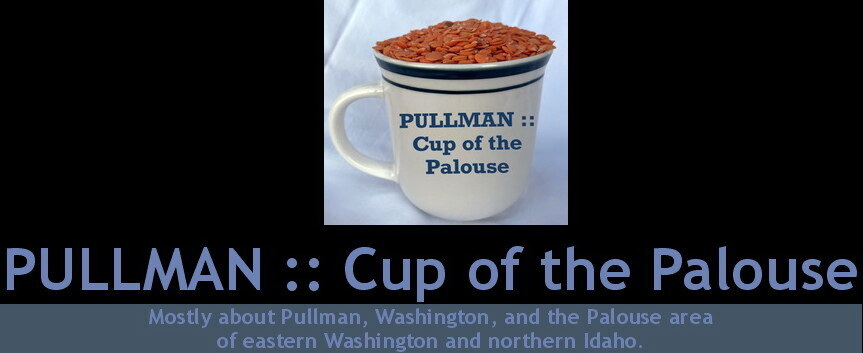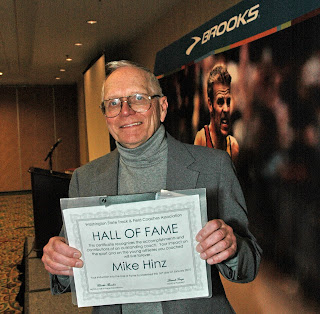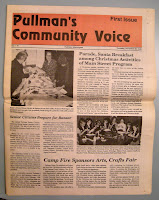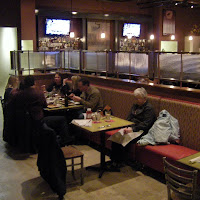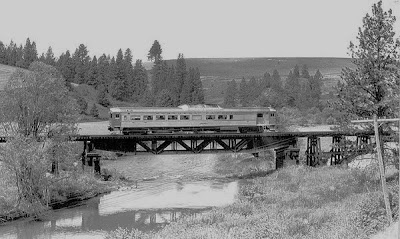
 May 29, 2010 Moscow Pullman Daily News, said "Contributed photos." Maybe so, but the person who took these two photos is Jim Fredrickson.
May 29, 2010 Moscow Pullman Daily News, said "Contributed photos." Maybe so, but the person who took these two photos is Jim Fredrickson.
- The Northern Pacific “Bug,” a self-propelled passenger rail car, on its way to Spokane.
- "The Bug" prepares for its last ride in March of 1966, cramming 131 passengers on the 96-capacity, self-propelled train. Here it is stopped at the Moscow depot before heading to Lewiston, then Spokane.
The little ‘bug’ that stopped
By Brandon Macz
History Column in Moscow Pullman Daily News of May 29, 2010Reaching far back in history to 1912, it turns out there were actually five railroad companies providing scheduled passenger service in Latah County at that time, one of them being Northern Pacific. In 1951, the "Bug," a self-propelled, one-car train, was commissioned to do just what my friends and I had imagined - run as far as Spokane or as close as Pullman or Lewiston.
The late Lillian Otness, who was strongly involved in the historical society (even receiving a reward from the city of Moscow for outstanding achievement in historical preservation in 1991), attributed the rapid growth of Latah and Nez Perce counties in the early 1900s to the railroad system.
As far as sources go, this posthumous endorsement seems sound to me.
In "its heyday," Crandall explained, that was the most popular mode of transportation until it was later thinned from the herd by the automobile.
"Now, passenger-rail travel in the U.S. is basically a joke," he said.
But Crandall remembers the shiny, silver car that ran on tracks and farther away from civilization than the highways. "You absolutely saw the countryside. You had no responsibility.
You just sat back and looked." As far as mass transportation goes, that sounds pretty nice.
When Crandall was a boy attending Franklin Elementary School in Pullman, taking a field trip on "the bug" to Moscow was a "big deal," and since trains were so popular, "It was very economical." And it didn't have to stop in Moscow. Passengers could go on to Troy, Kendrick, Juliaetta or Lewiston.
These areas lucked out because of the general topography of Latah and Nez Perce counties. With grades as severe as they are, the "Bug" had to take the safe, not suicidal route. Imagine a train on a track taking the same route as Highway 95 from Moscow to Lewiston and hitting the grade just outside the latter city. Add a thick, fall fog to that and try to enjoy yourself.
Jeanette Talbott, of Moscow, remembers riding the train when a child could go from Moscow to a rural station right on the Idaho-Washington border just south of Palouse for just 10 cents, while an adult would pay about 25 cents. But the trains wouldn't stop at depots and other platforms unless people could be seen, which Talbott said wasn't always easy at night.
"I remember that my father lighted a newspaper and flagged it down when it came in at night, " she said.
The sad thing about transportation, as could be said about any fad (we now have Segways that are so ridiculous they have to be cool), is it is prone to irrelevance. The automobile rose up through time starting in the 1920s throwing out the Ford Model T, becoming more reliable and affordable.
In March of 1966, "the bug" took its last ride, as the photo (above) shows, stopping at the Moscow depot and then Lewiston and Spokane. While Crandall said everybody came to accept the end of "the bug" and other modes of passenger trains, 131 passengers cramming into "the bug," which seats 96, on its last ride tells me there exists others who remember this time.
Talbott took her son and his wife on that final ride and said, "We felt lucky to be on it."
"We wanted to be a part of that last run," she said, adding she didn't feel passenger trains would ever come back. "I'm afraid it's passed, because the railroad tracks have been taken up.
"I wonder if we'll ever be sorry that we lost our railroads?" she asked.
Crandall informed me that when Spokane & Inland Empire Electric's train was nearing Viola, everybody knew because all the lights in the town would dim. I can imagine families receiving that dim message as the prepared for dinner then, waiting maybe for a loved one to return on one of those trains. Then they wait for that person to come through the door, their arrival noted only minutes ago. Sure, I have no personal recollection of these times.
But I can imagine.
Brandon Macz is the editor for Slice.
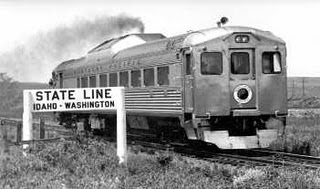 “Bug” in 1955 photo by Jim Fredrickson appeared in March 8, 2002, WSU Today.
.................................
Spokane, Washington Chronicle
Tuesday, Dec. 14, 1965
Testimony Goes Into Second Day
“Bug” in 1955 photo by Jim Fredrickson appeared in March 8, 2002, WSU Today.
.................................
Spokane, Washington Chronicle
Tuesday, Dec. 14, 1965
Testimony Goes Into Second Day
MOSCOW, Idaho – An Interstate Commerce Commission hearing on proposed discontinuation of Northern Pacific Railway passenger train service between Spokane and Lewiston went into an unexpected second day here today.
Examiner W. Wallace Wilhite of Washington, D.C., carried the hearing over another day because not all the persons wanting to testify could be heard yesterday.
Many are individuals from communities along the rail line who would be affected if NP Budd car service were discontinued.
Added Time Favored
Chairman Ralph Wickberg of the Idaho Public Utility District in his testimony yesterday suggested the present service be continued for as long as another year to permit further investigation of the NP plan.
But, Donald King, Spokane, NP district superintendent, said the NP is losing $91,000 annually on the service despite its efforts to encourage more use of the daily train.
History Cited
He countered suggestions that NP originate the daily run in Lewiston rather than Spokane by saying such a schedule with a separate train was discarded in 1950 because the extra train was used even less than the Budd car is used.
State Rep. George F. Brocke, D-Latah, testified on behalf of 23 Kendrick residents who, he said, rely on the train to get to Lewiston or Spokane.
Upon conclusion of the hearing, expected around noon, Wilhite planned to return to Washington and prepare a transcript of the hearing for the ICC, whose commissioners will make the decision.
Presenting protests of their states against discontinuing the NP passenger service were Lawrence Ripley, an assistant attorney general, of Idaho, and Morton M. Tyler, an assistant attorney general of Washington.
Only two witnesses were presented Monday by the railroad, whose attorney is Roger J. Crosby. They are Donald King, NP district superintendent, and Fred G. Huddle, Greyhound Bus Lines’ division superintendent, both of Spokane.
King shows that the passenger and express service is uneconomic for the railroad, despite unsuccessful effort to increase patronage. HE said that more frequent service had been discarded years ago because of lack of use and that there is no justification to resume it now.
Bus Service
Huddle outlined bus service presently offered to many of the towns served by the railroad and said Greyhound “would be happy to have additional passengers” who might use the bus if the train is discontinued. The bus does not serve Troy, Julietta or Kendrick, and Greyhound has no plans to extend its line to those towns, Huddle said.
“There are 23 residents in the town of Kendrick who have no other transportation than the train,” said State Rep. George F. Brocke, D-Latah County. He said they are older persons who do not own cars and that the town does not have bus, taxi or car rental services.
Mrs. Pearl Long, a window who said she has lived in Kendrick for 69 years, told of her use of the train for personal business such as trips to Spokane for medical care. She said she doe not like to ask friends to drive her. “I want the bug,” she said.
Chamber Objects
William Stellman presented a resolution of the Greater Lewiston Chamber of Commerce opposing termination. It was with withdrawn by Ripley when an objection of Crosby was sustained by the ICC examiner. But Stellman testified for the chamber against ending the train service.
Mrs. G.R. Spencer of Pullman said that termination of the service “would be disastrous” to her business of raising white rats for laboratory use.
She said the rats need moderate temperature and plenty of air when shipped, as provided by the railroad cars. “I know of no other way that would be satisfactory,” she said.
From Pullman
Pullman Mayor William Mitchell presented a Chamber of Commerce resolution opposing termination.
Carol Johnson, representing the Washington State University student body association, spoke against ending the service.
WSU faculty members who testified against termination include Arthur Stagler, A.A. Smick, Ruth Slonim and Dr. Herman Deutsch.
Opposition also came from Hugh Parks, for the Idaho State Grande; Ellick Bunney for several chambers of commerce in Latah and Benewah counties; Howard Lehn of Oakesdale, and David R. Tate of Moscow.
Spokane Washington Spokesman-Review
Tuesday, Dec. 14, 1965PUC Official Urges Study
Of Spokane-Lewiston Trail
MOSCOW, Idaho – Continuation of Northern Pacific Railway passenger and express service for up to a year during further investigation of and hearings on the NP’s plan to end the service was proposed by the president of the Idaho Public Utility Commission at an Interstate Commerce Commission here Monday.
Ralph H. Wickberg said, “Perhaps sufficient time has not been allowed, between the serving of the notice of discontinuance by the railroad and this year for preparation by those objecting to the proposal.”
Wickberg testified Monday afternoon before ICC Examiner W. Wallace Wilhite of Washington, D.C., in the Post Office Building here, at a hearing attended by about 100 persons.
Hearing Extended
The hearing, which was scheduled for only one day, was adjourned until 9:30 this morning.
The NP has served notice it plans to terminate trains Nos. 311 and 314, the on-car Budd Unit running daily between Lewiston and Spokane, called “The Bug.” The railroad said it is losing $91,000 annually on the service.
Testimony taking at the hearing will be referred to the ICC without recommendation or conclusion by the examiner. The commission may order a delay for further study up to one more year in addition to the current delay which resulted from the petition against the railroad’s announced termination last October.
Unless the commission rules otherwise, service may be ended by the railroad at any time after the current four month delay expires Feb. 19.
Many Testify
More than 20 persons, speaking as individuals or for organizations, trooped to the witness stand Monday to oppose ending the service. The were called by Asst. Atty. Gens. Lawrence Ripley, Idaho, and Morton M. Tytler, Washington.
Lewiston Idaho Morning Tribune
Monday, Feb. 28, 1966Passenger Train Business
Good Before Final Day Run
The Northern Pacific Railway passenger train had the greatest business in years yesterday – the next-to-last day it made the round trip from Lewiston to Spokane.
The train will make its last round trip today, but some 200 passengers chose yesterday to ride at least one leg of the journey. The Interstate Commerce Commission Thursday issued an order permitting the NP to end passenger service effective today.
C. Wallace Meckstroth, Lewiston NP agent, said 101 passengers were on the train when it arrived at Lewiston from Spokane at 12:55 p.m. yesterday. Most of them rode from the Pullman-Moscow or Kendrick-Juliaetta area as far as Lewiston and drove home.
Another 75-80 passengers were on the train when it left from Spokane at 3:30 p.m. A majority of the passengers went as far at Kendrick-Juliaetta or Pullman-Moscow.
For some of the passengers it was a final, sentimental journal, but for many of the children who took the trip it was their first – and perhaps last, for many years at least – ride on a passenger train.
Instructions to end service came Friday from St. Paul, headquarters for the NP.
Editorial by L.H. (Ladd Hamilton)
Lewiston Morning Tribune
Monday, Feb. 28, 1966
Lewiston’s Last Passenger Train
The Lewiston region’s last passenger train is scheduled to make its final run today, the Northern Pacific having convinced the Interstate Commerce Commission that it should not be required to any longer run this train at a loss.
The ICC’s decision to permit the discontinuance of the Lewiston-Spokane train is disappointing here, not only because it deprives this area of its last passenger train, but because it further weakens a principle that badly needs shoring up. The is the principle that any utility to which the public grants a monopoly should be expected to grant the public some service in return. The NP passenger train has been such a service. It has been, in fact, the only form of public transportation available to the people of Kendrick, Juliaetta and Troy. IT has been operated at a loss, but the loss has been more than made up for by the profits this regional generates for the NP in freight. We had hoped that ht ICC would consider this and base its decision on the railroad’s total operations here rather than on the passenger service alone. We still think it should have.
The NP argues that it tried unsuccessfully to attract more riders to the train, but the record does not indicate that it made any great effort to do so. The train was not much used because it was badly scheduled, and pleas to make the schedule more convenient got nowhere.
The NP observed, accurately, that the self-propelled rail car was not the most desirable means of traveling between Lewiston and Spokane; airplanes and private cars are faster, and buses are more convenient. But, when the planes weren’t flying and snow blocked the highways, the train remained available. IT was partly because the train remained available that the Idaho Supreme Court in 1959 permitted the Union Pacific to discontinue its passenger service into Lewiston.
The Northern Pacific, admitting that freight profits, more than offset the loss on the “bug,” has held that freight should not have to subsidize passenger service. This is saying that the railroad should not be required to provide any public service which does not make a profit. The ICC had an opportunity to rule otherwise and reestablish a sound public principle, but it chose not to do so. The result is likely to be a further erosion of the public responsibly of public utilities. – L.H.
Sunday March 6, 1966
Lewiston Idaho Morning Tribune
Riders Turn Train’s Last Run
Into a Sentimental Journey
A Tribune Picture Story by Roy Woods
(The following are photo captions. There was not a story.)
This view of Lewiston, from the rear of the NP “bug,” will be seen henceforth only by trainmen. Even when the train was running not many passengers saw it, simply because not many used the train – the chief reason it was discontinued after last Monday’s run.
Forty-three school children climbed aboard the self-propelled diesel car at Troy for the short run to Moscow. For most it was their first ride on a trip, and for some it will be the last.
Passengers piled aboard the Northern Pacific’s Lewiston-Spokane passenger car when it made its last run Monday to bid “the bug” a sentimental farewell. Here Conductor Raymond R. Soash of Spokane takes tickets from passengers who boarded the train at Lewiston.
This was the scene at the Moscow depot when the passenger train stopped there Monday evening from Lewiston to Spokane. The passenger load on the train’s last trip was the biggest since “the bug” was put into service 15 years ago. A total of 131 passengers boarded the train at Lewiston, and since the car’s capacity is only 96, some had to sit in the aisle, some stood and others used metal chairs set up in the storage department next to the engine.
The man at the controls of the last passenger train out of Lewiston was Engineer D. L. Bass of Spokane.
This photo (scroll up) by Jim Fredrickson appeared on page 6 in the March 8, 2002, WSU Today.
The Bug in 1955
The “Bug,” Northern Pacific Railway’s Budd Car B-30, shown at the state line between Pullman and Moscow June 12, 1955. The Bug ran round-trip between Spokane, Pullman, Moscow and Lewiston, until it was discontinued in the mid-1960s.
 Moscow Pullman Daily News Weekend edition, Nov. 21-22, 2009
Picture of the Past: The Bug on Feb. 28, 1966
Photo courtesy of the Whitman County Historical Society
Moscow Pullman Daily News Weekend edition, Nov. 21-22, 2009
Picture of the Past: The Bug on Feb. 28, 1966
Photo courtesy of the Whitman County Historical Society
Pullman rail service made its final run in 1966 in the form of the Budd RDC (Rail Diesel Car). The picture above shows the Budd RDC in front of the Burlington Northern Depot in Pullman, currently the RDC Real Estate offices, loading passengers prior to its final run Feb. 28, 1966,on what was then the Northern Pacific Railway line. A "Save the Bug" committee was organized to try to save the passenger service, and Pullman's Arthur Stabler, chairperson of the group, testified at the Interstate Commerce Commission hearing over the matter in 1966, but to no avail.
 It was showtime for Pullman’s Franklin Elementary School Jazz Choir on Jan. 29, 2010 as part of the University of Washington at Washington State University women’s basketball game.
It was showtime for Pullman’s Franklin Elementary School Jazz Choir on Jan. 29, 2010 as part of the University of Washington at Washington State University women’s basketball game.